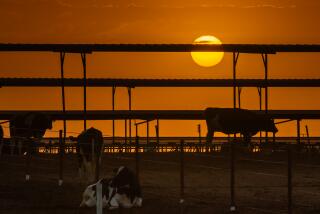Dreaded Cowbird Invades Santa Catalina Island
- Share via
Did you know that the nasty little cowbird has invaded Santa Catalina Island, where they feed in association with the bison herd there?
I didn’t until just the other day when I was informed of this by Dr. Allan A. Schoenherr, professor of ecology at Fullerton College and currently teaching coastal ecology at UC Irvine.
In fact, I didn’t even know there was a cowbird, although I used to milk cows when I was lots younger. All of my cows were earthbound creatures. I suppose a herd of cowbirds could be pretty exciting--especially if you were standing beneath them.
Along with cowbirds, Dr. Schoenherr is an expert on California’s wonderful, and, alas, much too often endangered, natural environment and its infinitely fascinating population of creatures, great and small.
I feel privileged to have read several chapters in manuscript form of Schoenherr’s new book, the working title of which is “A Natural History of California.” Now, it is undergoing peer review at the University of California Press and may become available by the end of this year.
As far as I’m concerned, Schoenherr’s revelations about cowbirds fall into the “Gee whiz, I didn’t know that!” department. In fact, there’s lots of interesting stuff like that in the few chapters I read.
His cowbird is among the “introduced species” to our land that he claims are posing serious threats to the natives.
For example, the house sparrow or English sparrow compete with native birds for food, nesting materials and nesting sites.
“The more house sparrows that occur in an area, the fewer other birds that can coexist,” he says.
He points to starlings, which have invaded the West in recent years. “These robin-sized black birds with yellow bills are very aggressive. They displace all sorts of birds that nest in tree cavities. Cavity-nesting birds that are being replaced include a variety of species--woodpeckers, bluebirds and small owls. House sparrows and starlings are examples of birds introduced from Europe that have been able to expand their ranges because they have no natural enemies here.”
And as for the cowbird, or more precisely, the brown-headed cowbird, it is native to the North American Great Plain, but not native to California. They migrated here. (And I wish they’d go home. We don’t need their kind around here. You’ll see why in a moment.)
These birds are members of the blackbird family. They even look like blackbirds, with stubby tails. The male cowbird is the same color as a blackbird, except its head is brown. Female cowbirds are brown. They differ from female blackbirds by being browner than they are. It’s pretty hard for the uninitiated eye to distinguish between real blackbirds and the villainous cowbirds in mixed flocks.
I said villainous. Schoenherr didn’t say it. You should judge for yourself what kind of citizen the cowbird really is.
The problem with cowbirds, says Schoenherr, is that they are nest parasites.
Female cowbirds sneak around and steal the eggs of native riparian birds from their nests and replace them with their own. The unsuspecting native birds then incubate the sneaked-in eggs and raise young cowbirds instead of their own offspring!
Now if that isn’t dastardly, I don’t know what is. And they are too lazy to sit on their own eggs. I realize I’m making a human moral judgment. Still, what would you think if you were a mother grebe, an egret or a heron and you hatched something that looked like a blackbird? I’m positive you’d know something underhanded had gone on. Birds may have bird brains, but you can’t tell me they’re too dumb not to know the difference between a cowbird and one of their own. It seems to me the only reason they raise the little stranger bird is because they think it’s an act of God and they’re too darn decent to kick it out of the nest.
It dismays me to learn that the brown-headed cowbirds have found their way to the peaceful environs of Catalina Island. When anchored in an island cove this spring, and I hear a heron screaming in indignation, I’ll know what happened.
More to Read
Sign up for Essential California
The most important California stories and recommendations in your inbox every morning.
You may occasionally receive promotional content from the Los Angeles Times.













